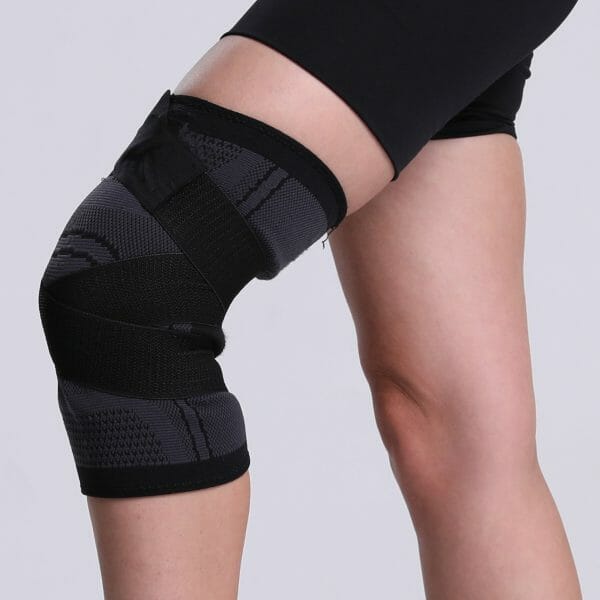Arthritis, a widespread and frequently incapacitating condition, affects millions across the globe and results in considerable discomfort as well as hindered mobility. This ultimately impairs an individual’s capacity to carry out everyday tasks and sustain a dynamic lifestyle. Knee arthritis stands out among the numerous types of arthritis, as it is especially widespread and greatly impacts the quality of life of those afflicted by it. So managing symptoms and addressing the causes of pain is crucial for enhancing a patient’s well-being and preserving their independence. In particular, utilizing proper knee supports has emerged as an essential strategy for combating the limitations imposed by this ailment. The use of braces has been shown to significantly provide pain relief, promoting stability, and allowing for enhanced mobility and functionality throughout the day. Moreover, the integration of knee supports into a comprehensive treatment plan can prove highly effective in preventing further injury and allowing continued participation in daily activities and physical exercise. Our goal is to shed light on the potential for improved knee health and enhanced mobility through the proper use of knee supports, ultimately empowering individuals to take control of their arthritis management and live a more fulfilling, active life.
Benefits of Knee Braces and Sleeves
One of the main advantages is pain relief. By providing compression and support to the knee joint, these aids help alleviate discomfort from swollen, stiff joints and distribute weight-bearing forces more evenly. This, in turn, improves stability, enabling one to perform daily activities with reduced pain and minimizing the risk of further injury.
Knee supports, such as braces and sleeves, can also improve mobility by promoting proper knee alignment and enhancing proprioception — the body’s natural ability to sense joint position and movement. Furthermore, these aids supply warmth and promote circulation around the joint, often relieving pain caused by conditions like chondromalacia patella (softening and breakdown of cartilage under the kneecap), bursitis, and patellar tendonitis. Discover the benefits for yourself with this knee support https://threo.nz/product/knee-support-for-running-walking-and-cycling-2/.
Indications for Using Knee Support in Arthritis Management
Utilizing a knee brace or sleeve might be beneficial if an individual experiences knee instability or buckling, frequent pain or swelling, or if additional support is required during physical activities. Addressing ligament injuries, meniscus tears, or other physical impairments might also warrant the use of knee support. Consulting a healthcare professional will aid in determining the most suitable support or brace to manage an individual’s specific arthritis symptoms and enhance comfort during movement.
Types of Knee Supports
An array of knee supports can be effective in managing arthritis pain and related symptoms, including:
- Knee Sleeves: These flexible, slip-on supports provide mild compression to the knee joint, enhancing stability and helping to control swelling. They are suitable for individuals with mild to moderate arthritis symptoms looking for additional support during daily activities;
- Functional Knee Braces: These semi-rigid braces typically feature adjustable straps, hinges, and bars to provide advanced support and stability to the knee. They are particularly helpful for those recovering from a ligament injury or surgery, offering added protection to the injured joint;
- Patellofemoral Braces: Designed to specifically support the kneecap, these braces aid in proper tracking and alignment of the patella, relieving pain from conditions like chondromalacia patella and patellar tendonitis. They are beneficial for individuals with arthritis who experience pain predominantly in the front or center of their knee;
- Unloader Knee Braces: Customarily prescribed for patients with moderate to severe osteoarthritis, these braces help redistribute the weight-bearing forces on the joint, relieving pressure on the affected areas and reducing pain. Rigid frames and adjustable straps characterize unloader knee braces, which can be custom-fit or available off the shelf.
Factors to Consider When Choosing the Perfect One
When selecting the appropriate one for arthritis, factors such as the type and severity of arthritis, lifestyle, physical activity levels, and recommendations from healthcare professionals should be considered. Additionally, the cost and insurance coverage of the support or brace may play a role in choosing the most suited option. It is essential to select knee support that effectively relieves pain, enhances mobility, and provides the necessary stability for the individual’s specific needs.
Conjunction with Other Treatments
An integrated approach to arthritis management often provides better outcomes. By integrating the use of braces with additional treatments, such as physical therapy, strengthening exercises, and suitable medications, individuals can better manage their arthritis symptoms and ultimately improve their overall quality of life.
Physical therapy and targeted exercises aim to strengthen muscles around the knee, improve joint flexibility and function, and reduce pain, ultimately contributing to better joint stability and the potential for increased mobility. Moreover, healthcare professionals remain vital in creating holistic arthritis treatment plans, addressing various aspects of a patient’s health, and ensuring that knee supports are used in conjunction with other appropriate therapeutic approaches.
Practical Tips
For those who have decided to incorporate knee supports into their arthritis management plan, it’s essential to make the most of these beneficial devices by understanding how to use them correctly. Choosing the right one is only half the battle; ensuring proper fit, maintenance, and usage are crucial factors that can significantly influence the effectiveness of these interventions in mitigating pain, improving stability, and enhancing overall joint functionality. By following these recommendations, individuals can better harness the benefits of knee support and play an active role in managing their arthritis symptoms and maintaining an improved quality of life.
Ensuring Proper Fit and Positioning
A well-fitted brace provides the necessary support without causing discomfort or impairing mobility. Loose fitting may compromise the support’s effectiveness, while an excessively tight fit could result in reduced circulation or skin irritation. Consulting an orthotist can help guarantee the correct size and positioning, maximizing the brace’s benefits.
Maintenance and Cleanliness
Keeping the knee support clean and in good condition is crucial for optimal performance and hygiene. Following the manufacturer’s care instructions and regularly inspecting the brace for signs of wear or damage ensures a longer lifespan and continued efficacy.
When to Wear and Remove the Support
Discussing the recommended wear times of the brace with a healthcare professional is advisable to prevent over-dependence on the device, ensure optimal benefits, and avoid potential complications. In conjunction with the advice from a healthcare professional, individuals should be attentive to any signs of discomfort or adverse reactions during prolonged use.
Addressing Potential Risks and Discomfort
While knee supports generally provide pain relief and improved joint stability, users should be aware of potential risks such as skin irritation, chafing, and reduced circulation if worn improperly. Consulting a healthcare professional can ensure proper fit and use while minimizing discomfort and potential complications.
Conclusion
Knee supports, including braces and sleeves, play a crucial role in arthritis management and pain relief, providing joint stability, improved mobility, and a consequent enhancement of an individual’s overall quality of life. Adopting a personalized, comprehensive treatment plan — including support devices, physical therapy, and medications — and consulting healthcare professionals to understand the best approach to managing arthritis symptoms, can yield the best possible outcomes. By understanding the various types available and following the practical suggestions for proper use, you can experience significant relief and maintain an active, fulfilling lifestyle.




